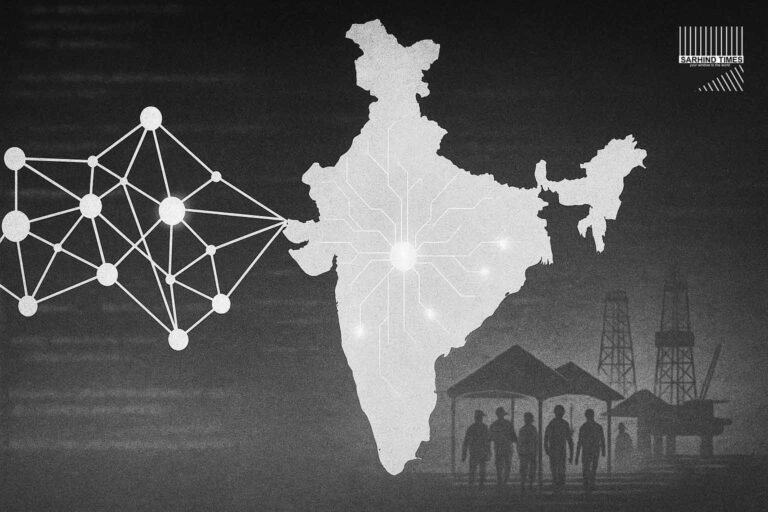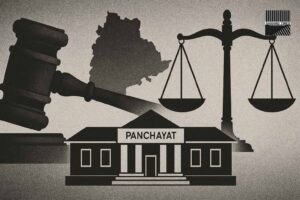Kolkata / Jhargram / Asansol, October 17, 2025 — Enforcement Directorate (ED) teams on Thursday carried out sweeping raids across 22 locations in West Bengal as part of an ongoing investigation into illegal sand mining and related money laundering. Premises of traders, suspected operators, mining sites, and associated offices in Kolkata, Jhargram (Lalgarh, Gopiballavpur), Asansol and peripheral districts were searched. Officials seized documents, scrutinised financial records, and ordered dozens of loaded sand trucks at river beds to unload cargoes pending further inquiry.
The move signals that the central agency is intensifying its focus on natural-resource crimes, where informality, environmental harm, and financial opacity intersect. For West Bengal, already grappling with allegations of sand mafia networks and riverbank degradation, the raids mark a new escalation in enforcement. As the ED reconstructs transaction trails, summonses, forensic accounting and potential asset attachments loom ahead. Below is a detailed look at the context, operation dynamics, legal and environmental dimensions, and what to expect going forward.
I. Background & Significance of the Sand-Mining Issue
Why Sand Mining Is a Major Flashpoint
Sand is a critical raw material in construction, infrastructure and real estate — cement, concrete, bricks, roads, buildings all demand huge quantities. In many regions, legal supply is constrained by regulatory limits, environmental restrictions, or bureaucratic delays. This scarcity, combined with high demand, makes sand mining a high-value, low-transparency business — fertile ground for illegal extraction, smuggling, overreach of leases, and corruption.
Unchecked extraction leads to severe environmental damage: riverbank erosion, depletion of riverbeds, destabilisation of aquatic ecosystems, lowering of water tables, disruption of habitats, and sediment imbalance. Local communities often bear the brunt in terms of flooding, land loss, and reduced groundwater access.
Because much of the trade is informal or clandestine, financial flows are likewise opaque — cash deals, underreporting, use of intermediaries and “benami” operators are common. This makes the activity a natural candidate for anti–money-laundering scrutiny.
West Bengal has long faced allegations of sand mafia networks operating in districts along rivers such as Kangsabati, Subarnarekha, and adjoining ghats. Activists and local media have repeatedly flagged illegal riverbed operations, unlicensed extraction, truck convoys, and collusion with local officials. The state has also seen earlier enforcement drives by state agencies, NGT orders, and public litigations, but enforcement has been patchy.
Previous ED Actions & Seized Evidence
This is not the first ED action in West Bengal’s sand-mining domain. In September 2025, the ED had conducted coordinated raids across 22 locations targeting suspected sand mining money laundering, recovering documents, digital devices, and cash.
Earlier, in a prior round of raids, the ED had seized nearly ₹90 lakh in cash across multiple locations: ₹25 lakh from Sheikh Jahirul Ali’s residence in Jhargram and ₹64 lakh from sand trader Sourav Roy’s home in Midnapore.
These earlier actions and seizures suggest a widening net — authorities appear to be building a trail of financial evidence to connect mining operations with illicit money flows, investments, shell companies, and real estate.
Thus, Thursday’s raids seem part of a sustained, cumulative enforcement strategy rather than a one-off show.
II. The Operation: What Happened & Where
Scope & Targeted Locations
According to ED sources and media reports:
- 22 premises across the state were raided, including residences, offices, mining sites and associated properties.
- Key search zones included Kolkata (Salt Lake, Bentinck Street area), Lalgarh, Gopiballavpur (Jhargram district), and Asansol (Paschim Bardhaman district).
- The residence of sand trader Manish Bagadia in Asansol was one of the properties raided. Bagadia is alleged to have wide operations in sand trading across multiple districts. Properties linked to Sourav Roy, including his mining sites and residence in Midnapore, were also under scrutiny.
- Offices of GD Mining in Gopiballavpur were searched.
- On a riverbed site along Sijua (Kangsabati riverbed), nearly 100 trucks loaded with sand were found; ED authorities instructed the truckers to unload their cargo and vacate the area.
The operation began early in the morning, with multiple ED teams operating simultaneously to prevent tip-offs or coordinated resistance.
What Was Seized / Inspected
The ED teams focused on:
- Financial and corporate business records, accounts, ledgers, invoices, bank statements, and digital devices.
- Property documents, land titles, leases and mining permits.
- Cash, if present, though details of new large seizures haven’t yet been confirmed widely.
- Physical evidence from mining sites — trucks, sand loads, licenses, weighbridge logs.
- Proxy and paper shell entities possibly used to mask ownership or financial flows.
Local law enforcement and district officials were reportedly assisting, including in accessing restricted premises or environmental clearances.
Immediate Impacts & Disruptions
- The order to unload 100 laden trucks at Sijua disrupts immediate trade flows and creates friction for operators.
- Mines and ghat operations may have been halted, or access restricted by ED presence.
- Some premises may face temporary sealing or official locks pending further forensic work.
- Fear, uncertainty and reputational damage among traders and intermediaries in the sand business.
III. Legal, Financial & Investigative Dimensions
The ED’s Mandate & Legal Authority
Under the Prevention of Money Laundering Act (PMLA, 2002), the ED investigates the proceeds of crime, attachment of illicit assets, and enforcement of seizure or prosecution of money laundering offenses. When a predicate crime (e.g. illegal mining, environmental violations, fraud) is involved, the ED can trace financial flows, properties and investments linked to it.
In this case, the underlying predicate offence is illegal sand mining / smuggling / violation of mining laws and possibly tax evasion, environmental violations, and money laundering via layering, concealment or benami investments.
ED must establish the proceeds of crime (PoC), show that assets or money are linked (directly or indirectly) to illicit activity, and then seek attachment, freezing, prosecution, or confiscation.
Forensic Accounting & Trail Reconstruction
A key challenge for the ED will be reconstructing transaction trails:
- Linking mining revenue to bank deposits, investments, real estate, shell companies, or cash circuit.
- Distinguishing legal vs illegal extraction revenue, quantifying illicit margin.
- Identifying intermediary entities, loan routes, false invoicing, and flow through multiple entities.
- Tracing benami or proxy ownership (front companies, family trusts, nominee holdings).
- Use of digital evidence, call data records, GPS logs, truck movement, weighbridge records, contracts.
- Cross-state or cross-district coordination if operators span multiple jurisdictions.
Environmental & Statutory Violations
Parallel to the ED probe, environmental statutes and mining laws may come into play:
- Violations of state mining acts / sand mining rules (extraction without permit, over-extraction, violation of quotas or bans).
- Breach of National Green Tribunal (NGT) orders or river protection guidelines.
- Liability under environmental statutes for river damage, habitat destruction, ecological compensation.
- If state agencies or local bodies are complicit, there may be administrative or criminal accountability under environment / forest laws.
The overlapping domain means that ED findings could feed into or coordinate with state or tribunal actions, strengthening case portfolios.
Risk of Counterclaims & Litigation
Those raided may push legal challenges:
- Petition the courts for quashing of search warrants or claims of procedural infractions (e.g. failure to follow PMLA norms, invalid ED orders).
- Contest asset attachment or freezing.
- Claim that some sites or properties were legitimately operated and thus protected.
- Use political, local pressure or media narratives to claim harassment or overreach.
Hence, ED must ensure strict procedural compliance — chain of custody, search protocols, witness records, detailed inventorying and legal backing.
IV. Political, Administrative & Environmental Stakes
Political Ramifications
In West Bengal’s politically vibrant environment, this raid will be closely watched. Key implications:
- Opposition and ruling party may trade charges: is this selective enforcement, political targeting, or genuine clean-up?
- Local leaders, especially in rural and peri-river districts, may feel pressure from constituents whose livelihoods are tied to nodal mining operations.
- The central agency’s action may be politicised, with narratives of federal overreach or center vs state tussle.
Administrative & Governance Accountability
The raids raise questions about governance:
- To what extent have local authorities, municipal or panchayat bodies, or district administrations enabled or tolerated illegal mining?
- Are permits, licenses, environmental clearances and inspections enforced?
- Are leach lines, revenue records, royalties or state mining levies being collected, and where is leakage occurring?
- How many officials (forest, revenue, mining, transport, local enforcement) may face retrospective scrutiny?
These questions may lead to parallel state audits, vigilance inquiries, or departmental reorganization.
Environmental & Social Impact
The environmental stakes are high:
- Riverbank erosion, siltation, loss of aquatic life and wetlands may already be underway; further illegal mining compounds damage.
- Communities living near rivers and ghats may face land loss, flood risk, wells drying, and disruption of agriculture or fisheries.
- Ecological restoration and compensation (if mandated) may require resources and planning.
Civil society groups, environmental NGOs and public interest litigations may leverage ED findings to press for stricter regulation, removable leases, or structural reforms in sand mining governance.
V. What Happens Next — Expected Moves & Strategic Options
Summons, Prosecution & Asset Attachment
- The ED is likely to issue summonses to key individuals (Bagadia, Roy, operators) to appear and explain records.
- If evidence is sufficient, prosecution complaints under PMLA may be filed, seeking trial in special courts.
- Attachment / freezing of assets (land, bank accounts, companies) suspected to be proceeds of crime may follow.
- Where assets are found to be clean or legally owned, appellants may contest attachment in appeals.
Further Raids & Expansion of Network
- The current raids may represent the first wave; as forensic leads emerge, additional rounds of search and seizure across districts or beyond West Bengal may be triggered.
- ED may coordinate with central agencies (Income Tax, CBI, Customs) to expand the case’s reach.
Cooperation with State / Environmental Authorities
- Exchange of information with state mining departments, forest & environment agencies, NGT, state pollution control boards, or district magistrate offices.
- Use of inter-agency task forces to monitor riverbeds, weighbridge logs, truck tracking, permit audits.
Policy & Regulatory Reforms
The raid may become a catalyst for deeper reforms:
- Re-examining sand mining regulatory frameworks — clearer leases, auctions, oversight, royalty structure, environmental checks.
- Introducing digital tracking of sand movement, mandated weighbridge logs, GPS tracking on trucks, barcoding of sand loads.
- Periodic audits, transparency portals, stakeholder involvement (villagers, NGOs) in monitoring.
- Strengthened penalties and enforcement triggers for violations or repeated offences.
Legal Pushback & Safeguards
The ED and investigative wings must safeguard procedural integrity:
- Maintain rigorous legal compliance (warrants, search procedures, inventory, witness logs).
- Maintain tight chain of custody of seized material and documents.
- Be ready for interlocutory court challenges in High Courts or Supreme Court.
- Ensure rights of persons under investigation are respected to minimize successful procedural writ petitions.
VI. Risks, Challenges & Limitations
Proving Illicit Linkage
Proving that mining revenue or property is illicit rather than legitimate is often complex. Operators may argue legal licensing, audited accounts, or legitimate business margins. Distinguishing “illegal overage” from permissible extraction or sale becomes a contested line.
Regional & Jurisdictional Complexity
Operators may have cross-district or cross-state exposure. Coordinating enforcement across jurisdictions (West Bengal, Jharkhand, Odisha) may complicate investigations.
Time Lag & Evidence Loss
In mining operations, physical evidence may get destroyed, concealed, or relocated. Delays in action reduce chances of clean evidence capture. Remote sites and riverbeds are hard to secure.
Political Interference or Local Pushback
Local actors may resist enforcement, use political clout to delay investigations, or intimidate witnesses. Ensuring protection for witnesses and ensuring independence is crucial.
Litigation & Procedural Wrinkles
Investigations of this scale often invite numerous legal challenges—search warrant quashes, plea to restrain attachment, petition for return of seized property, or claims of administrative overreach. The ED must be prepared legally at every turn.
VII. Strategic Significance — What This Means Going Forward
- Signal of Enforcement Intensification
The raids are a clear signal that the center aims to crack down on resource crimes more aggressively — not just in mining or minerals but in the intersection of natural resource exploitation and financial crime. - Deterrent Value
For operators and middlemen in the sand trade, the risk calculus now includes not only fines or shut-downs, but investigations, asset freezes, prosecution, and reputational damage. - Precedent for Similar Probes
Other states with sand mining challenges (Uttar Pradesh, Karnataka, Odisha, Jharkhand) may see similar moves, or enforcement agencies may use this as a template. Indeed, the sand mining issue is not new in India — UP’s sand mining scandals have been long in judicial record. - Integrating Environmental Justice & Financial Oversight
This aligns with broader trends: environment + resource crimes + money laundering investigations are increasingly merged. The case could deepen the integration of environment regulation, financial enforcement, and governance reform. - Pressure on State Governments
West Bengal and other states will face pressure to clean up regulatory lapses: better oversight, stricter licensing, real-time monitoring, digitization, and public accountability. - Potential Backlash & Litigation Landscape
Expect the case to become politically charged, with court battles, media narratives, local interventions, and perhaps demands for judicial oversight. The eventual judgment(s) may define new contours of resource-crime law in India.
VIII. Key Takeaways & Outlook
- The ED’s raids across 22 sites in West Bengal mark escalation in the state’s fight against illegal sand mining and money laundering networks.
- High-value operators such as Manish Bagadia and Sourav Roy, and associated mining offices, are under scrutiny.
- Investigative work will pivot heavily on financial forensics, property records, ownership tracing, and linking mining revenue to illicit assets.
- Environmental compliance authorities, local governments, and civil society have vital roles in sustaining oversight and ensuring remediation.
- Going ahead, expect prosecutions, asset attachments, deeper investigations, regulatory reforms, and possibly political turbulence.
This story is evolving. SarhindTimes will update readers as more details — court filings, notices, attachments, state responses — emerge over the coming days and weeks.
#ED #WestBengal #IllegalMining #SandMafia #Enforcement #Environment #MoneyLaundering #ResourceCrime #MiningProbe























+ There are no comments
Add yours